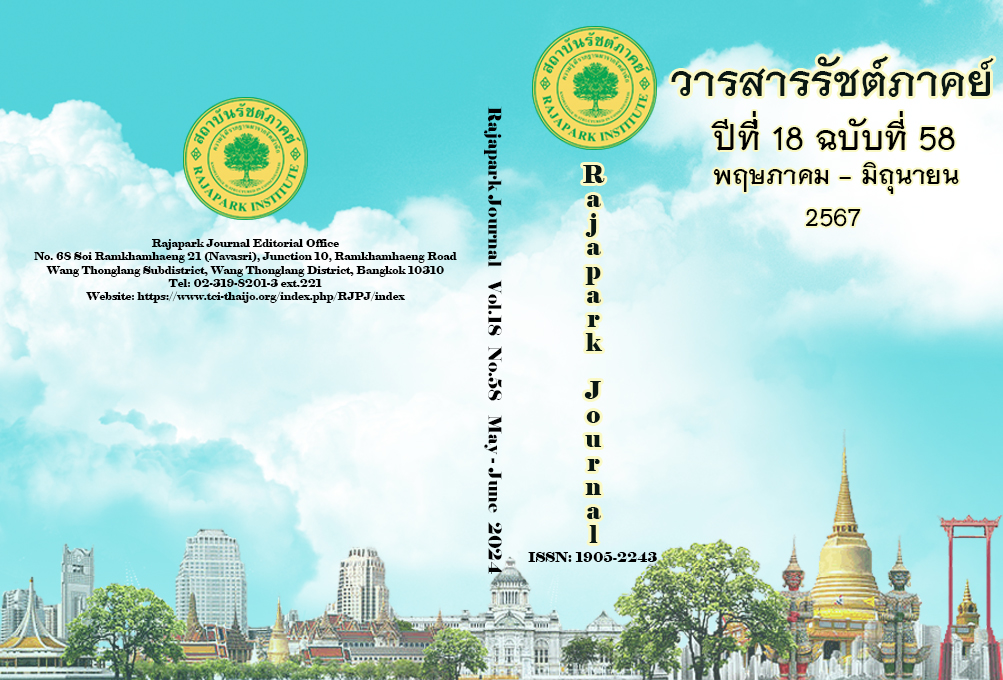Development of Online Learning based on the Art-Based Lateral Thinking Model to Promote Creative Thinking for Undergraduate Students
Main Article Content
Abstract
The objectives of this research were to 1) examine the current and expected needs of undergraduate students regarding online learning and 2) develop online learning based on the art-based lateral thinking model to promote creative thinking (OALT model). This study employed a mixed-methods research design across three distinct phases. The papers presented in Phases 1 and 2 investigate the need for assessment and model development for creative thinking development. The target groups encompassed nine instructors, nine subject matter experts, and a sample group, obtained through cluster sampling, consisting of 400 undergraduate students. Data was collected through document analysis, an in-depth interview, and a questionnaire. The subsequent data analysis was quantitative and qualitative statistics, including frequency distribution, percentage, mean, standard deviation, the PNImodified index, and content analysis. The research results were found as follows: 1) The current and expected needs that promote creativity, with the PNImodified values ranging between 0.25 and 0.85, showed that the aspect with the highest PNImodified was the process of promoting creative thinking. And 2) the OALT model consisted of 7 components: 1) Masterwork Analysis; 2) Conceptual Exploration; 3) Lateral Thinking Exercises; 4) Artistic Expression; 5) Reflection and Integration; 6) Collaborative Projects; and 7) Feedback and Revision. The assessment results indicated that the appropriateness of the model was at the highest level.
Article Details

This work is licensed under a Creative Commons Attribution-NonCommercial-NoDerivatives 4.0 International License.
Views and opinions appearing in the Journal it is the responsibility of the author of the article, and does not constitute the view and responsibility of the editorial team.
References
Brothman, D. S. (2013). The Leonard Bernstein Artful Learning Model: A case study of an elementary school. Other Dissertations, 1. https://digitalcommons.nl.edu/dp2013/1
Brown, A. (2021). The effectiveness of Six Thinking Hats in problem analysis and decision-making among engineering students. International Journal of Engineering Education, 37(6), 1678-1689.
De Bono, E. (1990). Lateral thinking: Creativity step by step. HarperCollins.
Dhawan, S. (2020). Online learning: A panacea in the time of COVID-19 crisis. Journal of educational technology systems, 49(1), 5-22.
Eisner, E. W. (2002). The arts and the creation of mind. Yale University Press.
Gaunt, H. (2003). The role of art in education: A philosophical and historical perspective. Routledge.
Guangul, F. M., Suhail, A. H., Khalit, M. I., & Khidhir, B. A. (2020). Challenges of remote assessment in higher education in the context of COVID-19: A case study of Middle East College. Educational assessment, evaluation and accountability, 32, 519-535.
Guilford, J. P. (1967). Creativity: Yesterday, today and tomorrow. The Journal of Creative Behavior, 1(1), 3-14. https://doi.org/10.1002/j.2162-6057.1967.tb00002.x
Guilford, J. P. (1987). Creative talents: Their nature and development. American Psychological Association.
Hendriyani, M. E., Rifqiawati, I., & Lestari, D. (2022). Online learning videos to develop creative thinking skills of students. Research and Development in Education (RaDEn), 2(2), 67-75.
Jones, M. (2022). Using PMI to enhance brainstorming and decision-making in business organizations. Journal of Business Research, 145, 112-123.
Kieokaeow, T., Sarayutpitak, J., & Rodpipat, S. (2023). Effects of health education learning management using visual thinking strategies on learning achievement and creativity of secondary school students. Journal of Thailand National Sports University, 15(1), 129-140.
Ko, H. C., & Yoon, J. (2020, April). Artful science: Integrated digital arts for the gifted and talented students to learn science. In Society for Information Technology & Teacher Education International Conference (pp. 1423-1429). Association for the Advancement of Computing in Education (AACE).
Manoy, J. T., & Sari, A. P. J. (2021). Students’ creative thinking based on motivation to learn during online learning. In E3S Web of Conferences (Vol. 328). EDP Sciences.
Martin, F., & Bolliger, D. U. (2018). Engagement matters: Student perceptions on the importance of engagement strategies in the online learning environment. Online learning, 22(1), 205-222.
Muangsrichan, K., Chatruprachewin, C., & Chaowchai, S. (2023). An administrative model for developing innovator characteristics of students in educational opportunity expansion schools. Journal of MCU Peace Studies, 11(2), 531-542.
Office of the Education Council, Ministry of Education. (2018). National Education Standards B.E. (2018). Office of the Education Council, Ministry of Education.
Piotrowski, M. (2009). Document-Oriented E-Learning Components. Otto-von-Guericke University. https://files.eric.ed.gov/fulltext/ED533734.pdf
Rasheed, R. A., Kamsin, A., & Abdullah, N. A. (2020). Challenges in the online component of blended learning: A systematic review. Computers & Education, 144, 103701.
Robinson, K., & Aronica, L. (2016). Creative schools: The grassroots revolution that's transforming education. Penguin books.
Sawyer, R. K. (2017). Teaching creativity in art and design studio classes: A systematic literature review. Educational Research Review, 22, 99-113.
Silva Pacheco, C. (2020). Art education for the development of complex thinking meta competence: A theoretical approach. International Journal of Art & Design Education, 39(1), 242-254.
Smith, J. (2023). The effects of SCAMPER on the development of lateral thinking skills in primary school students. Educational Psychology, 43(2), 245-260.
Sternberg, R. J. (1988). The nature of creativity. Cambridge University Press.
Supandi, S., Suyitno, H., Sukestiyarno, Y. L., & Dwijanto, D. (2021). Creative thinking of Prospective mathematics teacher based on learning barriers and self-efficacy. Journal of Southwest Jiaotong University, 56(6), 779-793. DOI:10.35741/issn.0258-2724.56.6.69
Torrance, E. P. (1965). Scientific views of creativity and factors affecting its growth. Daedalus, 663-681.
Wongwanich, S. (2007). Needs assessment research. Chulalongkorn University.
Wongyai, W., & Pattapon, M. (2020). Creative learning. Charansanitwong Printing.
Xie, H., Chu, H. C., Hwang, G. J., & Wang, C. C. (2019). Trends and development in technology-enhanced adaptive/personalized learning: A systematic review of journal publications from 2007 to 2017. Computers & Education, 140, 103599.
Yamane, T. (1973). Statistics: An introductory analysis (3rd ed.). Harper and Row.


